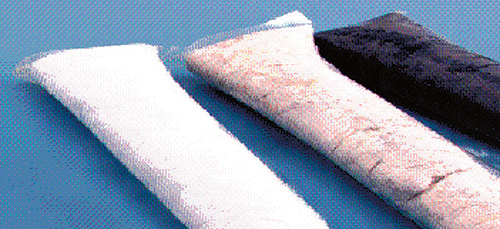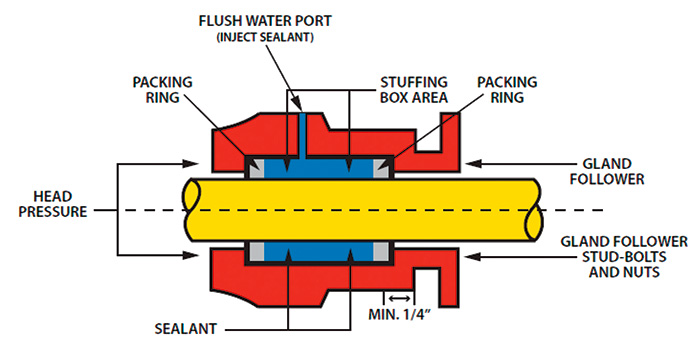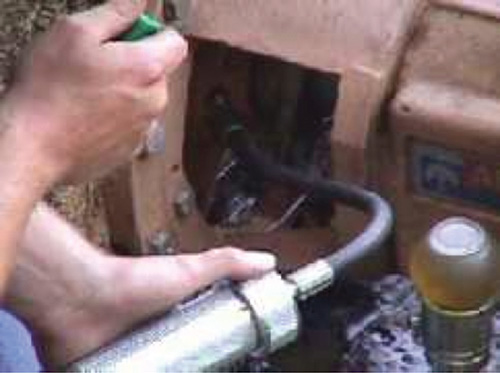Pumps & Systems, April 2013
Injectable sealants are made of milled fiber particles—such as polytetrafluoroethylene (PTFE), PTFE/graphite, aramid, flexible graphite and other synthetic materials. High-temperature lubricants are added to help the sealant flow throughout the stuffing box, filling all voids. Lubricants also help the sealants pass through the water flush hole when injected. Sealant can be pumped into the stuffing box with an injection gun and is usually applied between the outer and inner rings of conventional braided or molded packing.
The sealant’s ability to fill any crevice makes it an effective seal on worn or grooved shaft sleeves. Highly lubricous sealants require no coolant flush water. They can be formulated for varying conditions—from high acidity to high alkalinity (0 to 14 pH), temperatures up to 1,200 F (649 C) and pump pressures up to 300 psi (20 bars).
Injectable sealants provide a number of major advantages including:
- Virtually leak-free operation
- Easy to install, which requires less training of personnel and allows application in difficult-to-access areas
- Lower energy and operating cost
- Extended equipment life
- Reduction or elimination of downtime
- Provides a positive seal in valves that do not meet fugitive emission requirements
- Injected online if valves are not compliant

Image 1. Three grades of injectable sealant
How Injectable Sealant Works
To effectively seal a pump with braided packing, the inner most ring of the packing closest to the media must be properly compressed to seal the pumped media. This process is difficult because braided packing is compressible and flexible. The outboard ring (the ring closest to the packing gland) must transfer the gland load to the inner most ring closest to the media without developing excessive frictional heat and hardening of the packing. Evidence of this is that little wear of the inboard ring occurs and an overly compressed outboard ring will be seen. As a result, the pump shaft or sleeve appears worn or highly eroded in the area under the packing ring. This is not the case with injectable sealant because it works by exerting hydraulic pressure on both the inboard and outboard packing rings, creating an effective seal.
The sealant can be initially hand packed between the two braided, beveled-cut packing rings—one ring at the inboard of the stuffing box toward the media and the other packing ring at the outboard toward the packing gland. An injection gun can be used by connecting it to a button head or an easy-flow fitting installed in the pump flush water port. With the button head fitting, sealant can be added while the equipment is in operation.
The high-pressure gun is not required when injectable sealant is the first to be used in a stuffing box. A tamping tool can be used to compact the sealant. When the area between the two braided packing rings is completely full, the packing gland is firmly tightened but not over tightened. The pump is started, and the packing gland bolt is slightly adjusted to allow the pump to run leak free.

Figure 1. Typical installation of an injectable sealant in a pump stuffing box
Case Study: Injectable Sealant in a Mine
Slurry Pump
A slurry pump was operating at 150 F, 250 psi at 300 rpm. Its packing ring was installed in the bottom of the pump stuffing box preceded by several ounces of injectable sealant, which was hand packed into the stuffing box, tamped until compacted and then a second slurry packing ring was installed at the outboard followed by the packing gland. The gland was tightened snuggly before the pump was started.
Two flats of stud nut adjustment were made after the packing had run in. This pump ran for eight months without leakage or the need for further adjustment. The plant mechanic used the high-pressure gun to add additional sealant through the flush NPT after the eight-month run.
Case Study: Injectable Sealant for a Horizontal Food Processing Mixer
A food processing mixer (operating at 200 F, 200 rpm and 100 psi) did not have a packing gland. Therefore, a packing cartridge seal was retrofitted with food-grade packing and food-grade sealant. A flange was welded to the mixer where the packing assembly—comprised of a hard coated sleeve, packing housing and gland follower—was attached. The packing rings and the injectable sealant were pre-installed into the packing housing. The gland follower was tightened before the unit was bolted on the mixer, and the sleeve was fastened to the mixer’s shaft with set screws. This unit has been in operation for four years with one rebuild each year. 
Image 3. Installation with a high pressure gun
Other Applications
Injectable sealants can be used in many applications. Some other examples are:
- High-temperature service—Injectable sealant made from graphite fibers and high-temperature lubricant and fillers is formulated to perform in high-temperature applications. Due to the excellent heat dissipation property of graphite, friction heat and process heat will easily dissipate through the sealant to the surface of the pump box. This action allows the packing to continue to run at an acceptable temperature without burning the lubricant in the sealant.
- Food and beverage or pharmaceutical applications—Specially processed U.S. Food and Drug Administration (FDA) compliant PTFE fibers with approved food-grade lubricant is used to seal the pump stuffing box with two end rings of FDA-compliant packing material. The PTFE low friction capability allows the pump to operate without high frictional heat, which can damage the packing and shorten seal life.
- Abrasive service—A compound made from meta-aramid fibers or high-strength, spun aramid fibers blended with high-grade lubricant is used to seal mine slurries, paper stocks and most media with suspended abrasive particles. The end rings used with the sealant are also made from high-strength packing yarns. Because of the high tensile strength of the aramid, the suspended solids are prevented from destroying the packing.
Conclusion
Injectable sealants have been around for years. These products are versatile sealing solutions. Typical equipment that can use injectable sealants is centrifugal pumps; reciprocating pumps; and rotary mixers that handle cooling water, aqueous solutions, oils or solvents, particularly in processing sectors such as pulp and paper, metallurgical, and mineral and power. Injectable sealants are often used because they readily conform to worn shafts or irregular housings.
The combination of high-performing fibers and specially treated fillers and lubricants also make these sealants a viable alternative to conventional packing and has help improved meantime between maintenance for many types of equipment. Process plant operators have reported annual savings of up to 30 percent in maintenance costs and a significant reduction in plant water usage when they converted problem pumps and valves to injectable sealants.
Next Month:
How can packing solve my difficult sealing problem?

